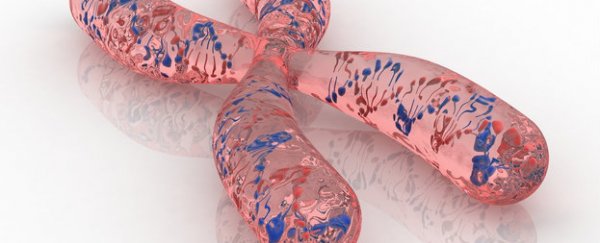Researchers have figured out what causes neochromosomes - monstrous, DNA molecules that are found in certain cancer cells - to develop. The findings explain that these giant, hybrid DNA strands are actually keeping tumours alive, and offer a new target for anti-cancer drugs.
The nucleus of every cell in your body contains about three metres of DNA that's all tightly packed into 23 pairs of chromosomes. In the 1950s, scientists noticed the presence of 'extra' chromosomes in certain cancer cells that were unusually massive compared to normal chromosomes.
They called these monster chromosomes neochromosomes, and soon discovered that they're found in up to three percent of all cancers - including liposarcomas (tumours of fat tissue), sarcomas (soft tissue tumours) and some brain and blood cancers.
How neochromosomes develop into monstrous sizes has remained a mystery, and up until now researchers were unsure of what role they played in tumours.
Australian researchers from the Garvan Institute of Medical Research have now discovered that neochromosomes are created like Frankenstein's monster - by being stitched together from loose DNA after normal chromosomes have exploded. Even more scary, this hybrid chromosome contains huge amounts of oncogenes - gene mutations that are known to fuel tumour growth.
"These cancers manipulate the normal replication process in an ingenious way, creating a monster that can selectively steal and amplify the genes it needs to grow and survive," said David Thomas, cancer specialist and one of the researchers, in a press release.
To study the development of these monster chromosomes, the team mapped neochromosomes from tumours found in fat tissue using DNA sequencing. Next, the team used mathematical modelling to reconstruct the sequence of events that cause a neochromosome to form in the first place, and found that it all starts with the shattering of healthy chromosomes. This process is called chromothripsis and occurs when a chromosome loses telomeres, which are the caps on the end of the chromosomes that hold it together.
After a chromosome shatters, DNA-repair mechanisms try to piece it together. Normally the chromosome dies as the pieces are joined together randomly, but on the odd occasion it survives. But without telomeres to cap it, the ends join together to make a ring. As the cells continue to divide and replicate, the circular chromosome is torn apart unevenly into different cells. Over thousands of divisions, it also sucks up more bits of DNA from other shattered chromosomes, gradually forming a monstrous structure.
Interestingly, this giant chromosome is more likely to amplify cancer-causing genes throughout the enormous circle. But the monster chromosome doesn't stay circular forever. Eventually it stops growing and becomes linear, and from there it replicates itself just like any normal chromosome in the body.
The tema's results are published in Cancer Cell.
Although neochromosomes are bad news for cancer sufferers, learning more about their unique evolution has now helped scientists identify a new potential drug target.
Importantly, they've blocked the activity of the tumour-fuelling genes in the giant chromosomes, and found that this helped to eradicate the cancer.
"In a heartening aspect of this work, when we blocked the activity of key oncogenes that were massively amplified in the cancer cells, they died, which opens up new avenues of research to combat their ability to survive and thrive," said Tony Papenfuss, bioinformatics scientist and one of the researchers, in a press release.
Watch this cute animation by Armando Faigl to learn more about the role of neochromosomes in cancer:
